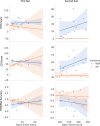Neurophysiological Correlates of Concussion: Deep Learning for Clinical Assessment
- PMID: 31758044
- PMCID: PMC6874583
- DOI: 10.1038/s41598-019-53751-9
Neurophysiological Correlates of Concussion: Deep Learning for Clinical Assessment
Abstract
Concussion has been shown to leave the afflicted with significant cognitive and neurobehavioural deficits. The persistence of these deficits and their link to neurophysiological indices of cognition, as measured by event-related potentials (ERP) using electroencephalography (EEG), remains restricted to population level analyses that limit their utility in the clinical setting. In the present paper, a convolutional neural network is extended to capitalize on characteristics specific to EEG/ERP data in order to assess for post-concussive effects. An aggregated measure of single-trial performance was able to classify accurately (85%) between 26 acutely to post-acutely concussed participants and 28 healthy controls in a stratified 10-fold cross-validation design. Additionally, the model was evaluated in a longitudinal subsample of the concussed group to indicate a dissociation between the progression of EEG/ERP and that of self-reported inventories. Concordant with a number of previous studies, symptomatology was found to be uncorrelated to EEG/ERP results as assessed with the proposed models. Our results form a first-step towards the clinical integration of neurophysiological results in concussion management and motivate a multi-site validation study for a concussion assessment tool in acute and post-acute cases.
Conflict of interest statement
The authors declare no competing interests.
Figures




References
-
- McCrory, P. et al. Consensus statement on concussion in sport—the 5 th international conference on concussion in sport held in Berlin, October 2016. Br. J. Sports Medicine bjsports–2017–097699, 10.1136/bjsports-2017-097699 (2017). - PubMed
Publication types
MeSH terms
Grants and funding
LinkOut - more resources
Full Text Sources
Medical

